
While others were busy checking out the shores of Pulau Hantu, I headed down to explore a shore I've become very fond of.
Every time I take a closer look at the islets off Siloso Beach, I never fail to be amazed at the vast array of interesting creatures that survive in these waters. But my motive for visiting this shore was also to see if there was any visible impact from the oil spill that recently occurred in the area.
When I reached Siloso Beach, I was a little surprised at the small groups walking around. Further down, I heard loud music and a lot of cheering. Ah yes, it was another one of those beach parties. Turns out that part of Siloso Beach was being used for Gilles Peterson's Worldwide Festival, which was taking place at Café del Mar.
There are 4 islets along Siloso Beach, but for obvious reasons, the only islet that I am able to explore is the one connected to Siloso Beach by a floating bridge, and as far as I knew, that particular islet was situated almost opposite Café del Mar. I was a little worried that I would not be able to gain access to the beach and the floating bridge. True enough, the section of beach next to Café del Mar was fenced off, with burly security personnel and a Private Function sign making it obvious that I would have to seek an alternative route.
There was another way to reach the floating bridge, but as I drew closer, I was stunned for a moment.
The bridge was gone!
Instead, there was nothing but a stretch of open water. I was willing to get my feet wet, but I certainly wasn't prepared to swim.
I turned around, and to my relief, I saw that the bridge had been moved to the neighbouring islet. So sometime in the 4 months since my last visit, the bridge had been shifted over.
I quickly made my way over, very relieved, but also a little worried. On previous visits when the bridge was at its original location, the lower parts of the bridge were well-encrusted with a thick assorted carpet of barnacles, bivalves, algae, soft corals, sponges and ascidians. Fish and crustaceans hid among the seaweeds, while snails of all sorts fed on the organisms growing on the bridge. How much life had been wiped out when the bridge was moved? Not to mention the effects on the shore where the bridge used to be; there were tiny patches of spoon seagrass (Halophila ovalis) at the base of the bridge, and nowhere else along the shore. Now that the bridge has been removed, are the seagrass patches still around?
In any case, this presented a new opportunity. I got to explore another one of the islets, and to see how much it differed from the one that I used to visit.
It seems that there is still plenty of life encrusting the bridge. I have no idea how much of it consists of organisms that were originally growing before the bridge was moved.
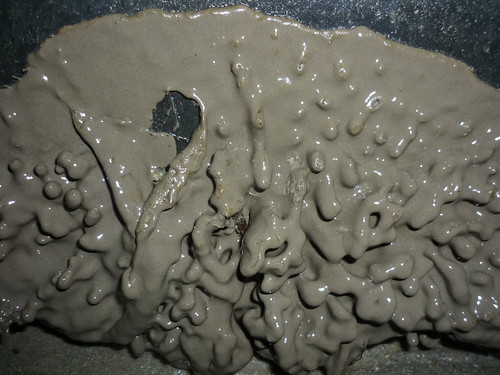
The dominant lifeform on many parts of the bridge is the rock slime ascidian.
Previously, there were vast blooms of sargassum seaweed (Sargassum sp.). However, most of it has cleared up, and other types of seaweed can now be seen growing on the bridge.
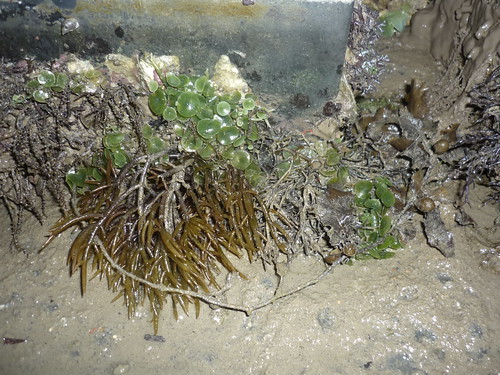
You can see at least 3 different types of algae in this photo.
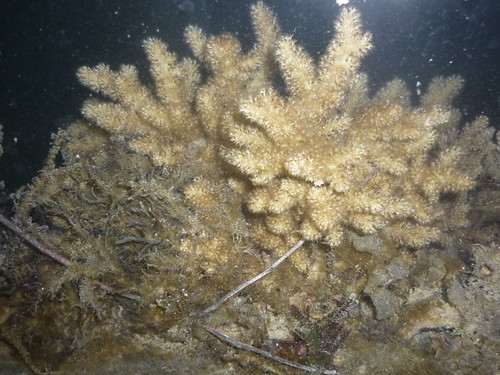
There is also quite an impressive number of soft corals.
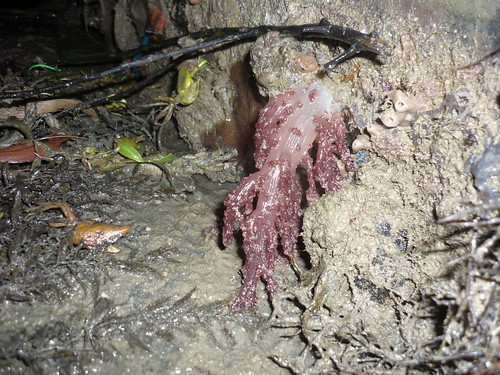
In one of the gaps, I find a pink flowery soft coral.
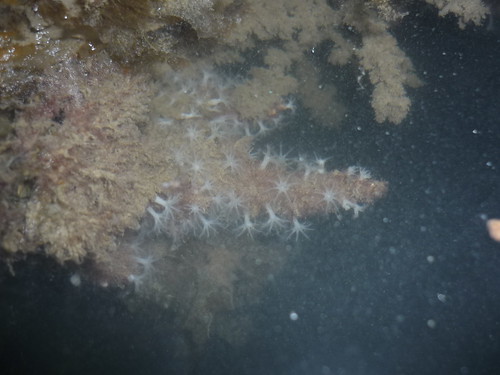
Do these polyps belong to a sea fan (O. Gorgonacea)?
There is a wide variety of snails on the bridge.
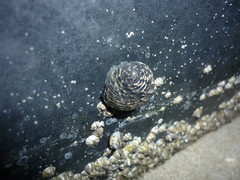
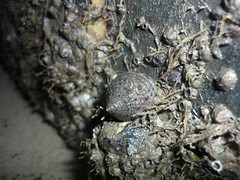
The waved nerite (Nerita undata) and toothed topshell (Monodonta labio) are placid grazers.
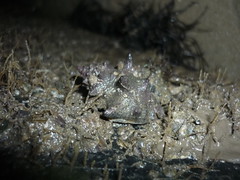
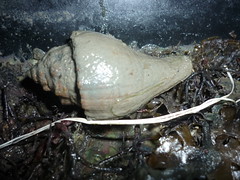
While the spiny drill (Thais bitubercularis) and spiral melongena (Pugilina cochlidium) are predators.
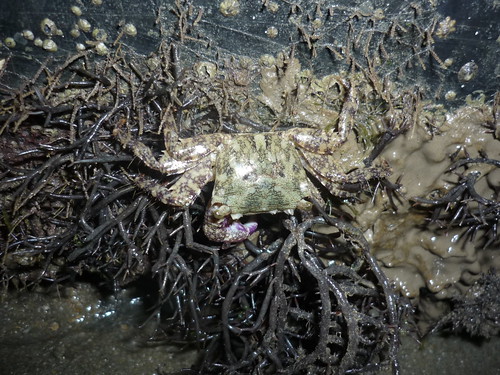
There are several purple climber crabs (Metopograpsus sp.) hiding amongst the seaweed.
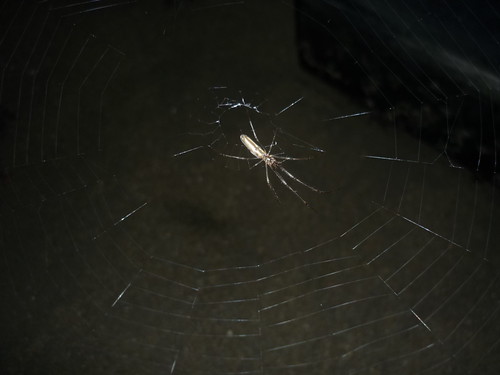
I did not manage to explore some parts of the bridge, due to the presence of a few common big-jawed spiders (Tetragnatha mandibulata), which had spun their webs over the water. I was unwilling to destroy their webs in my search for marine life.
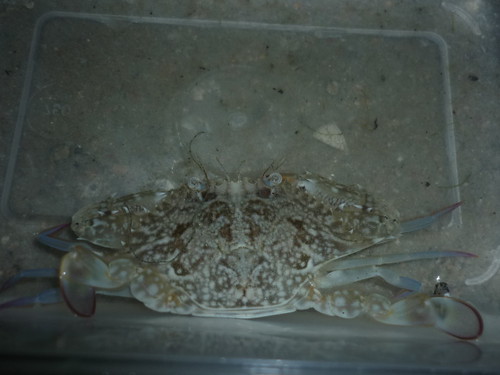
This small flower crab (Portunus pelagicus) was found on the seabed near the bridge.
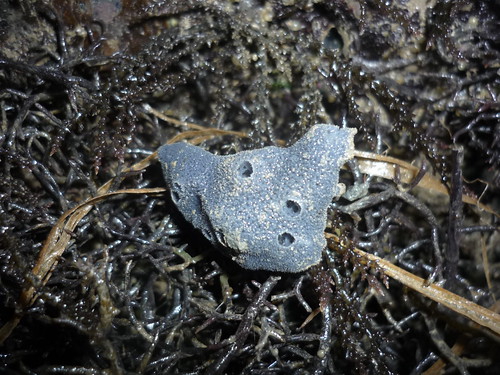
I spotted this tiny piece of blue sponge (Haliclona sp.) perched on a clump of seaweed.

I was a little thrilled but not surprised when I flipped it over and as expected, found a tiny sponge crab (F. Dromiidae) hiding beneath. The sponge crab snips off a piece of living sponge, which it then wears on its carapace. Perfectly camouflaged until it moves, the crab is able to remain hidden from predators.
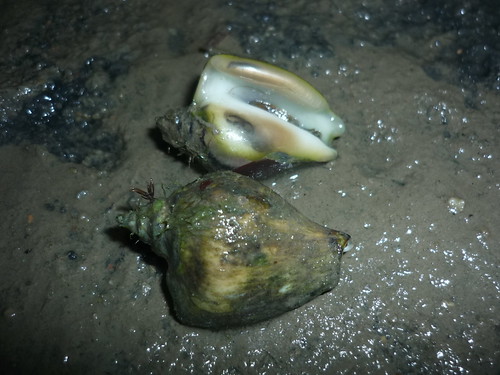
I was pleasantly surprised to discover a very healthy population of pearl conch (Laevistrombus canarium) on this islet. Populations on many other shores are heavily impacted by collection for food. The conch here are quite small in size, but very abundant. Most accounts list the snail we commonly know as gong-gong as L. canarium, although I'm wondering if it might be L. turturella instead.
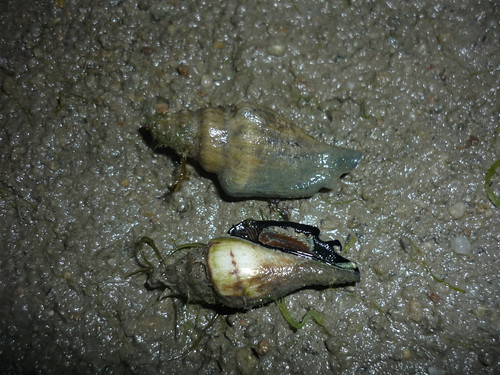
The black-lipped conch (Canarium urceus) is present in small numbers.
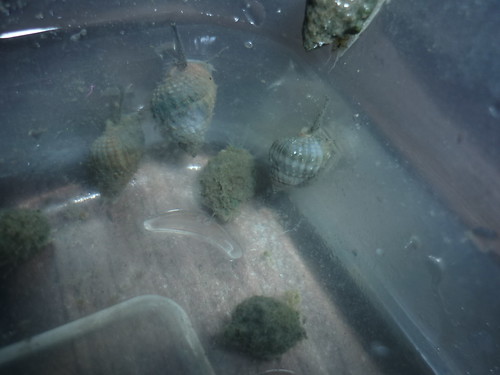
One can also find huge numbers of whelks crawling around on the silt. 2 species are present, the common whelk (Nassarius livescens ) and the prickly whelk (Nassarius crenoliratus)

In the sandier parts of the shore, I find small groups of blue-tailed prawns (F. Penaeidae) in the shallows. Although their bodies seemingly vanish against the seabed, the light reflects off their eyes. When threatened, they quickly bury themselves in the sand.
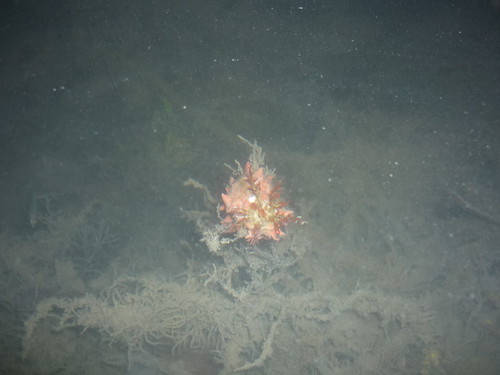
For once, here's a creature that didn't need the use of a net.

Like many of the other animals I've found on these islets at Siloso, the thorny sea cucumber (Colochirus quadrangularis) is more characteristic of Northern shores like Changi.

I explored the rocks at one end of the islet, and found this orange fanworm.

This tiny patch of zebra coral ( Oulastrea crispata) was the only sign of hard corals I could find amongst these rocks.
As the sky began to brighten, I headed to the rocks on the opposite end of the islet. There, I found some larger colonies of hard corals, but they were in deeper water, which was far too murky for me to take any usable photos.
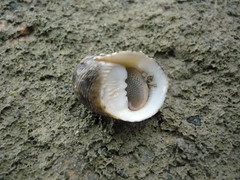

There were plenty of snails here; more spiny drills, waved nerites and toothed topshells, as well as ribbed turban snails (Turbo intercostalis). I saw a couple of spotted topshells (Trochus maculatus), but I forgot to take photos of them.
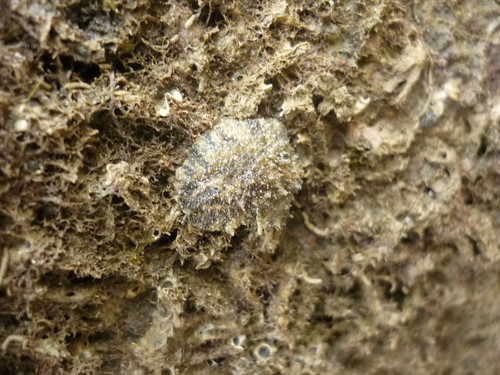
There was also a big pimply onch slug (F. Onchidiidae).

Like the other islet, there was a solitary tape seagrass (Enhalus acoroides).
I had found common seastars (Archaster typicus) on my last visit to the other islet, so I was on the lookout for any signs of seastars on this shore.

After a lot of searching, I finally stumbled upon this pair almost by accident. They were so well-hidden in the sand that I had nearly stepped on them. The common seastar is 1 out of 2 species of seastar which engages in what is known as pseudocopulation. No mating actually takes place, but the chances of successful fertilisation increase when the time comes for the male and female to release their gametes.
It was great to see that there were common seastars on this particular islet as well, although I was hoping to find more than just 2.

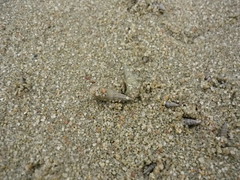
The upper part of the shore, where the ground is sandier, is carpeted with zoned horn snails (Batillaria zonalis), most of which have buried themselves in the damp sand to await the return of the tide.
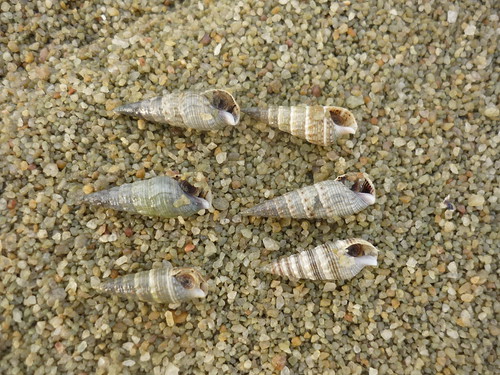
There is a wide variety of shell patterns in this species.
As I headed back towards the bridge, I disturbed at least 3 or 4 spotted moon crabs (Ashtoret lunaris). All of them proved too quick, heading straight for the deeper water.

I finally managed to catch and photograph one of the moon crabs. Moon crabs are extremely feisty, and they pinch hard, so dealing with one at close quarters requires a fair bit of skill and bravery. Oh, and a high threshold for pain.

Just as I was releasing the moon crab, I noticed something washing up on the shore at my feet.
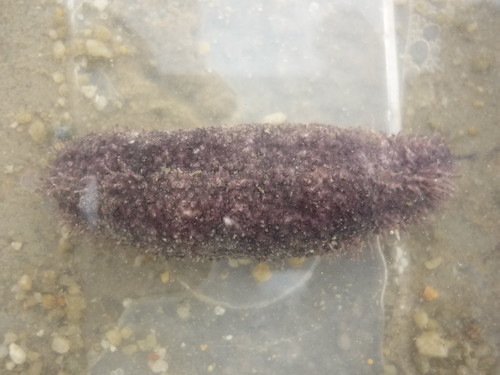
It was a purple sea cucumber (F. Cucumariidae), another creature more commonly associated with Northern shores.
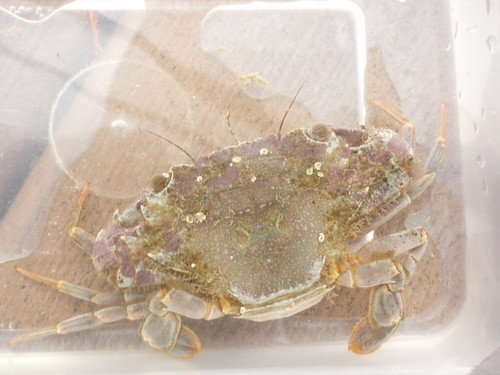
Among the seaweeds encrusting the bridge, I found this swimming crab (Thalamita sp.). I have no idea which species it is, as parts of its carapace are covered in coralline algae. It could be either the blue swimming crab or blue-spined swimming crab.
I headed back towards the rocks, as I had left my flashlight and headlamp there. Then, almost by accident, I stumbled upon what I had been hoping to find.
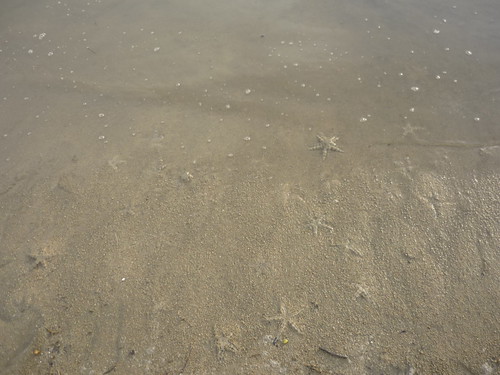
It was a common seastar colony! Almost all were well-buried in the sand, with just bits exposed here and there.
I was extremely thrilled. I got down and started counting, and by the time I was fairly sure that every visible seastar in the area was accounted for, I had arrived at a jaw-dropping figure of 90 or so.

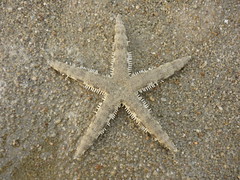
I unearthed some of them for closer examination.
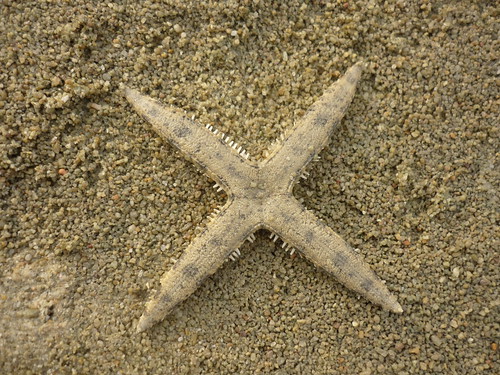
There were a couple of 4-armed individuals amongst the seastars.
It's hard to describe how I felt at that point in time. Common seastars are present in large numbers only on some of the Southern Islands, such as Pulau Semakau and Pulau Hantu. Chek Jawa used to be another stronghold, but the population there is still making a slow recovery after the mass death that occurred in late 2006. And while I had found small numbers of common seastars on the other islet, this was the first time I had ever seen such a large group of seastars here on Siloso Beach.
I have to say, this was the highlight of the entire trip. I only hope that other visitors to the shore leave the seastars alone and don't collect them.
Like I've mentioned many times before, exploring the islets at Siloso Beach is not for the faint of heart. The terrain can be treacherous, and the water is usually too murky to take decent photographs. I didn't mention that one also has to have a very high tolerance for wading in the midst of an absolutely disgusting mess of marine trash.
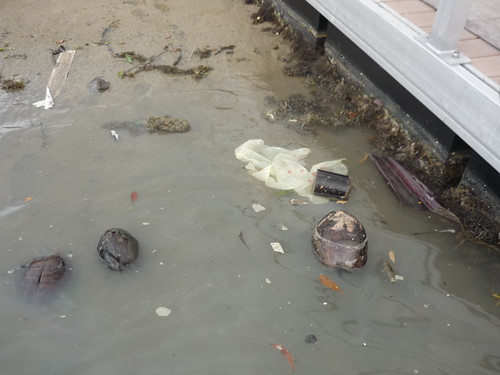
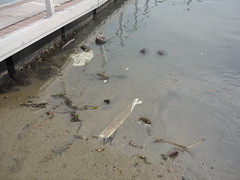

Assorted bits of flotsam accumulate along the bridge. Much of it is of natural origin, consisting of bits of seaweed, leaves, and the fruit and seeds of coastal plants. But a lot of the trash is man-made; wooden planks, food wrappers, slippers, plastic bags and containers, bottles, labels, pieces of styrofoam and the like. There are patches of disgusting frothy scum in some areas.

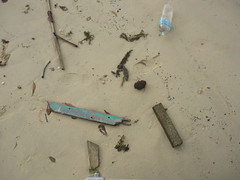
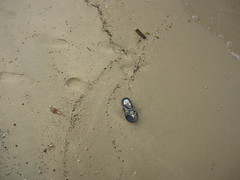

Some of this rubbish drifts in from the open sea, but I'm sure that a significant proportion comes from careless and inconsiderate beach-goers.



The islet I was exploring had some sort of construction work going on.
I hope the shores won't be too badly affected.
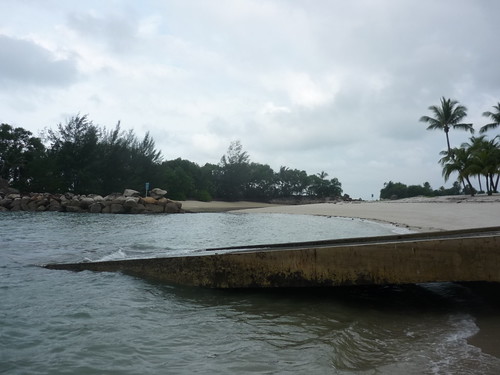
In 2006, I first discovered the large variety of marine life that inhabited these lagoons. I was out on a suntanning trip and for fun, decided to swim across to this particular islet. In a way, it was this islet that got me interested in exploring Siloso Beach. Now the entire area is out of bounds due to construction work.
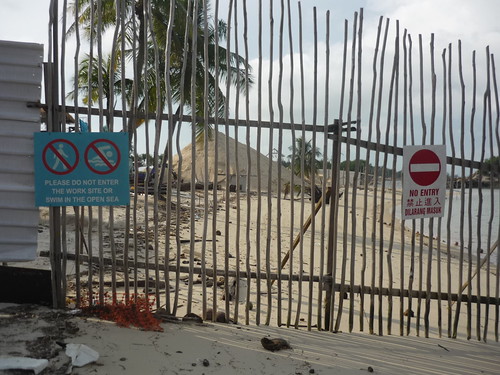
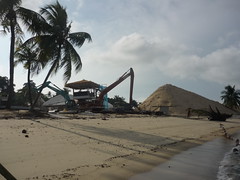

There's more construction work taking place on this other stretch of Siloso Beach, just next to Café del Mar.
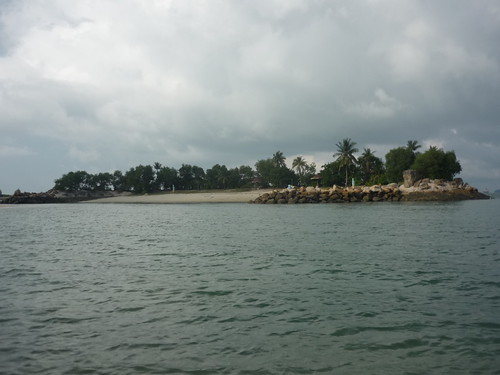
The construction work is taking place almost directly opposite this islet, the one that I used to visit on previous occasions, when it was still connected to Siloso Beach by the bridge.
Siloso Beach is undergoing a lot of heavy development, as this news report shows.
Two massive structures are already being built that will house two of four new attractions planned for the beach.
One is a 7,650 sq m hotspot with three wavepools and a three-storey complex with bars and a restaurant.
The other site spans 1,870 sq m with a double-storey entertainment complex, offering activities such as banana boat rides.
Another new hang-out is a treetop high-rope course, where participants swing over obstacles. All are due to open this year and by next year, Singapore's first indoor skydiving simulator will be located on the 1.2km beach too.
I hope that in the near future, Siloso Beach won't become so crowded that all the marine life is crowded out as well. It would be extremely saddening for me if the lagoons of Siloso Beach became genuinely sterile and lifeless.
But for the time being, I have to admit, I guess the shores are still doing pretty well, despite all the marine litter, development and the oil spill that had happened a few days before. Nature can be resilient, and often, even under the most inhospitable circumstances, life finds a way.
This is part 1 of a 2-part series on a trip to Siloso Beach on 10th May, 2009.
Part 1: Seeing Stars on a Siloso Shore on Sunday (this post)
Part 2: Finds with Spines on Siloso